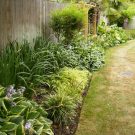Planting ferns
Article Written by : Home Interior Advices Ferns are a beautiful addition to a home or garden. However, most people may be reluctant to plant ferns as they may think that ferns are difficult to grow or maintain. Here are some tips to help with planting and maintaining ferns. Best time to plant – The best time to plant your ferns will depend on your geographic location. If you live in an area that experiences cold, wet winters, then you should plant your ferns in Spring. In warmer climates, look at planting ferns in cooler, wetter months as this will help the fern deal with the stresses of summer. Moving a fern – If you want to move a fern, start by digging a generous root ball around the plant. Then dig a hole the same size as the root ball in the place you...
How to grow lucky bamboo
Lucky bamboo is an easy houseplant that looks great in kitchens and bathrooms. Here are a few tips to grow and maintain a healthy lucky bamboo plant. Selection – Choose a plant with bright green leaves and stems. You can also look for plants that have been braided or curled to create intricate designs. Grow your bamboo hydroponically – The easiest, cleanest way to grow your bamboo is in water. You will need to fill a tall glass vase (avoid shallow bowls) with at least 1-3 inches of water. Positioning – Place your plant in a space that gets filtered light, similar to the light that creeps through a forest canopy. The plant will thrive in temperatures of between 65ºF and 90ºF.[4] Changing the water – You should change your water at least...
Five gardening tips for beginners
For some growing a garden can be hard work and for others it can seem effortless. If you haven’t found your green thumb yet ,h ere are 5 garden tips that will help you get started. Know your region – All plants will not grow in any region. Therefore, it is best grow plants that are suitable for your climate and soil type. This will make maintenance a whole lot easier and give you a garden that will flourish. Speak to someone at your local garden centre and ask them what plants are native to your region. Test your soil – Send a sample of your soil to your local nursery to get an idea of your soil’s PH and nutrient levels. The results will let you know how acidic or alkaline your soil is. This will be a good indication on what type of compost you...
4 Tips for evaluating your garden design
Most gardeners will dream of a ideas on how to redesign or improve their garden. Instead of getting frustrated at your gardening set backs, here are 4 tips for evaluating your garden design and creating a space that is rewarding. What worked – You should have an idea of a section of your garden that always worked well. This is the key to letting you know what sort of style and plants work best for your garden. Following this style will ensure your garden is always looking its best and an easy garden will give you more time to enjoy its beauty. What didn’t work – Remember the plants that always needed your attention, or those that never really grew to the plants you had hoped, these are the plants that should be avoided. These types of plants will...
The advantages and disadvantages of a cottage garden
A cottage garden is defined as an informal garden with old fashioned flowers and plants. Signature modern cottage gardens will have self sowing plants, bushes and plants spilling off the edge of pathways. Although this style of garden may look like it requires no care, a good deal of maintenance is involved. Here are some advantages and disadvantages of creating and maintaining a cottage garden. Advantages Personalized garden – Each cottage garden will look different from each other. Usually the plants in a cottage garden will change and flow with each passing year. Inexpensive and Economical – To create a cottage garden you will need a few packs of seeds and some patience. If you decide to spend money on larger plants like rose bushes and flowering...
5 Great ground cover plants
Ground cover plants take the fuss out of landscaping. They are dependable, hardworking plants, that will carpet your garden floor with minimal fuss. They also offer to control erosion for hilly landscapes and thrive in dry conditions, all the while beautifying your garden. Here are 5 great ground cover plants. Thyme – Thyme is a great aromatic plant that is best grown in borders, beds and containers. The plant features tiny, fragrant leaves and flowers, that can be used for cooking fresh or dried. The type that creeps, can handle a bit of foot traffic. Thyme will need sun, therefore tuck them between plants and stepping stones on garden paths. Sedums – These plants that have succulent leaves and stems. They grow best in low water areas and start...





Recent Comments